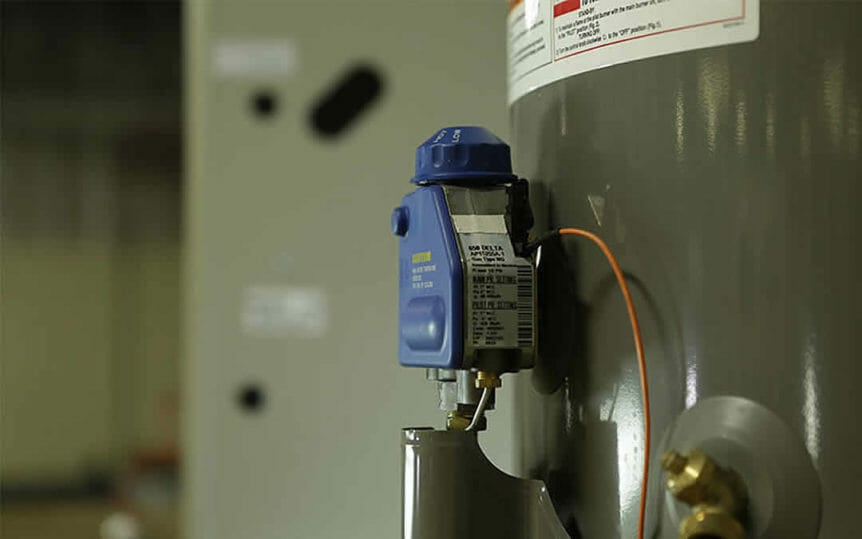
A Water Heater Control Panel Should Be Inspected Annually
Houston, we’ve got a problem- and responsible homeowners like you can often overlook it! When you are taking care of your water heater by giving it a good scrub, chances are you forget to pay close attention to one little area: the control valve. Sure, now that you are seeing it on paper, you probably are thinking, “of course!” But that isn’t the case most of the time.
Water heaters are familiar fixtures in most homes. They typically look like big metal tubes, or tall drums that are often put into a laundry room or attic. Newer styles have a few different features, like losing the tank entirely. Either way, they all have a place where the controls are. According to professionals in the industry, the control panel tends to break and malfunction if not properly maintained. It isn’t surprising to go on a call and realize that while the homeowner thought their water heater was broken, it was really just an issue with the control panel all along. That’s a huge relief, especially when you thought you were THIS close to having to shell out big bucks to get it fixed or worse, to replace it.
So let’s talk controls. What does the panel (sometimes referred to as the control “valve” or “board”) actually do? It depends on the type of heater, but all have very important and sometimes similar functions that allow your heater to work both safely and properly. And that, y’all, is always the goal.
Below is a glimpse of what you need to know about the control panel on two of the most common types before they malfunction or become damaged. Remember, getting your home’s most important systems working right starts with educating yourself, and we consider giving you the resources to do that just another part of our job at John Moore. Read on!
Traditional Gas Burner Controls
This traditional and reliable design that’s most widely used in the U.S. today is really a pretty simple appliance; it’s basically a drum filled with water and equipped with a heating mechanism on the bottom or inside.
In a gas water heater, a pipe that has its own gas shutoff valve supplies the natural gas or propane. Just like you need to know where the water supply shutoff valve is located, you need to know where the gas line shutoff is located as well. The gas line feeds into a gas burner control module that serves as a kind of thermostat for the heater.
The gas control valve is a part of the gas burner control module. It also controls the ignition of the pilot light, which is a small gas flame, usually natural gas or liquefied petroleum gas, which is kept lit in order to serve as the ignition source for the burner. This unit operates to control gas flow to the pilot light and as a thermostat by turning the gas to the burner off after water reaches the desired temperature. A thermocouple sensor detects when the temperature of the water drops and sends an electrical impulse to the thermostat control. Finally, the thermostat causes the burner to light and bring the temperature of the water back up to the temperature setting on the thermostat.
Electric and Gas Tankless Controls
With electric heaters, the anatomy of the controls is different than that of the gas heater controls.
Tankless systems avoid standby loss by heating incoming water on an as-needed basis (they’re also referred to as “on demand” heaters because of this). The elimination of the standby heat loss is why some say that a tankless system is more efficient. With tankless water heaters, you can choose from electric, propane or natural gas models. Point-of-use models (smaller systems that heat water for only one or two outlets) are generally electric, while whole-house systems are usually much larger systems powered by either natural gas or propane.
Another reason why many homeowners are switching to tankless: they are operated by a remote control component. That makes it easy to change the set point temperature. Some manufacturers use a standard remote that lets you set an alarm to the size of your tub. After you set your temperature and begin to fill the tub with water, the unit measures the gallons and an alarm sounds to remind you to shut off the water. Other manufacturers have been able to offer multiple remotes to serve the same heater so you can have multiple locations to change the temperature of the hot water if your little heart desires. Most digital remote control panels also run diagnostics for the heater in the event that there is a problem. They flash a fault code to help service personnel find and fix any problems that may come up quickly, something that is extremely helpful and efficient for both homeowner and technician.
The Do’s and Don’ts for Maintaining Controls
As you can see from what we have told you in this post, the controls attached to the various types of water heating systems do a lot to make your system work correctly, safely, and efficiently. Maintaining these parts is something a responsible homeowner should consider doing regularly by getting your water heater inspected by a John Moore professional, just as you would with the rest of your appliances. Here are some Do’s and Don’ts to consider:
–DO keep the controls area, unit, and/or valve clean. Clean, dust and vacuum as needed, making sure there aren’t any kinds of debris obstructing the area.
–DON’T ignore signs of rust. Rust is conductive – even when on the wire insulation. This can lead to potentially deadly shocks, heating and melting insulation and even burns.
–DO perform all care and cleaning to and around electric heaters with the system turned off and the electrical power supply disconnected.
–DON’T attempt to remove or fix any controls yourself if you are even slightly unsure of what the parts are, what they do, and what the problem actually is. Taking on tasks on your own can increase the risk of creating more problems.
–DO remember that safety is everything. Combustible materials, such as clothing, cleaning materials, or flammable liquids should never be placed against or next to it.
–DON’T assume anything. What seems like a small problem can actually be a big one in the eyes of an expert, and vice versa. When encountering an issue with your heater and the source isn’t clear, call someone right away to get it checked out to get to the bottom of it and plan a course of action. As we said before, educating yourself is key to responsible homeowner practices, and that includes consulting a trusted tech when you don’t know what’s going on.
–DO be gentle. Clean it and the remote control with a damp soft cloth and mild detergent. Gently wipe and completely dry all surfaces.
–DON’T forget to call John Moore with all your questions and concerns! We would love to help.
